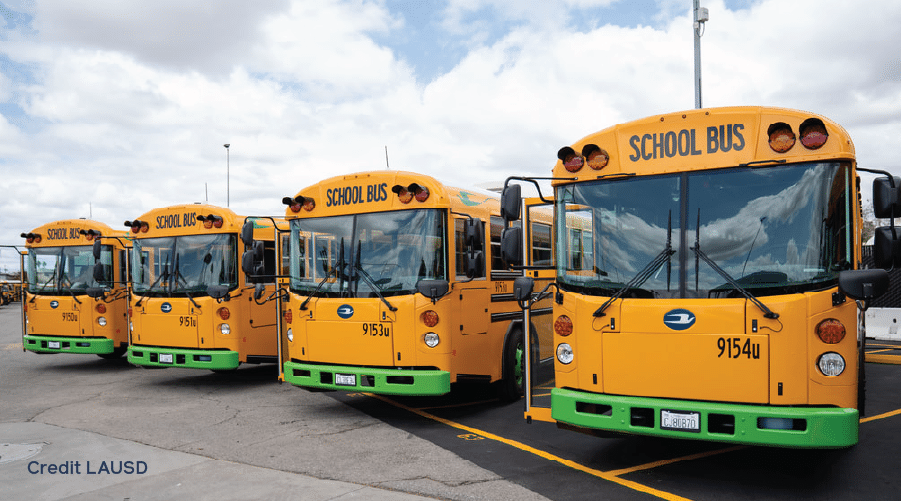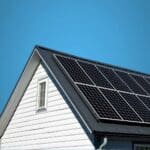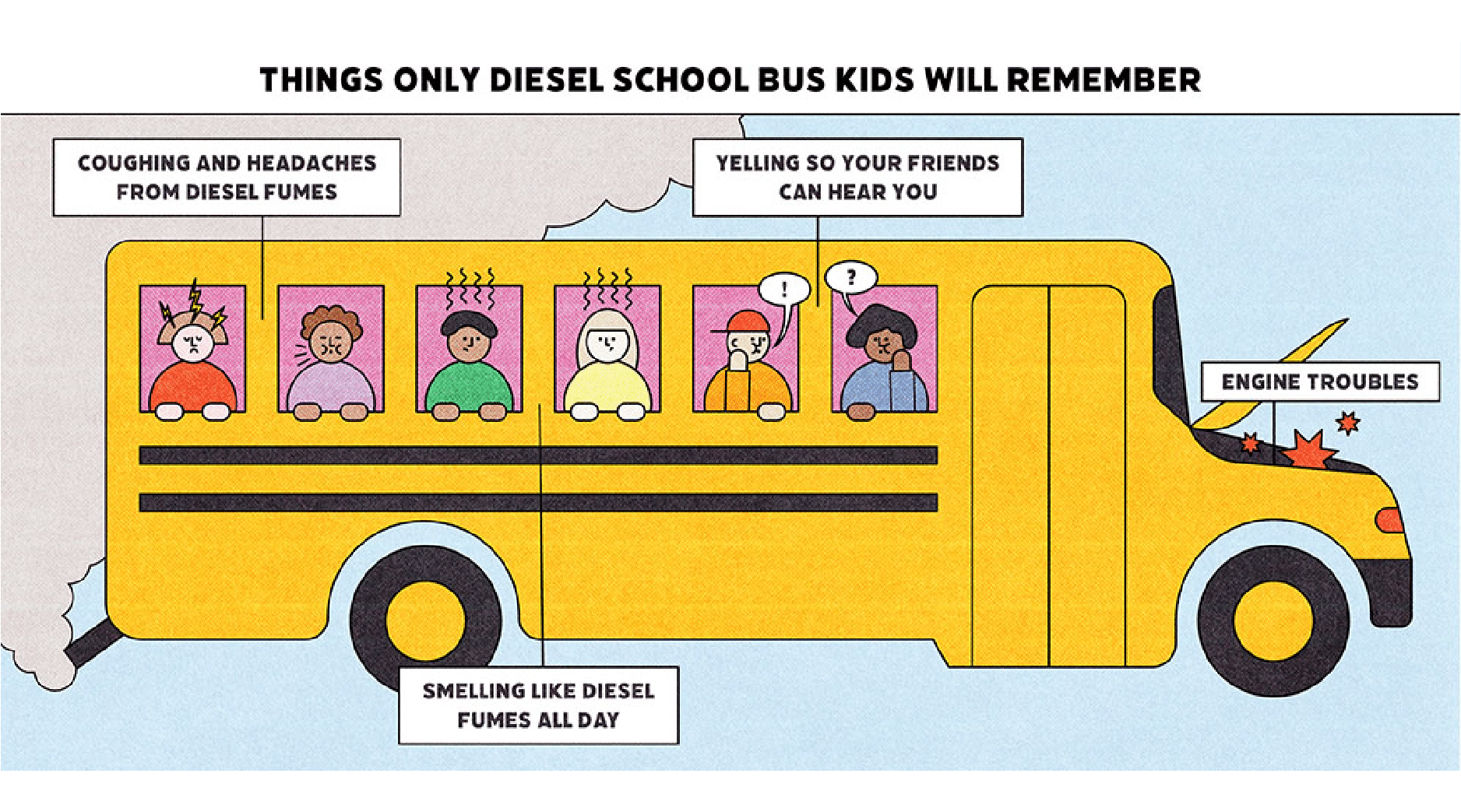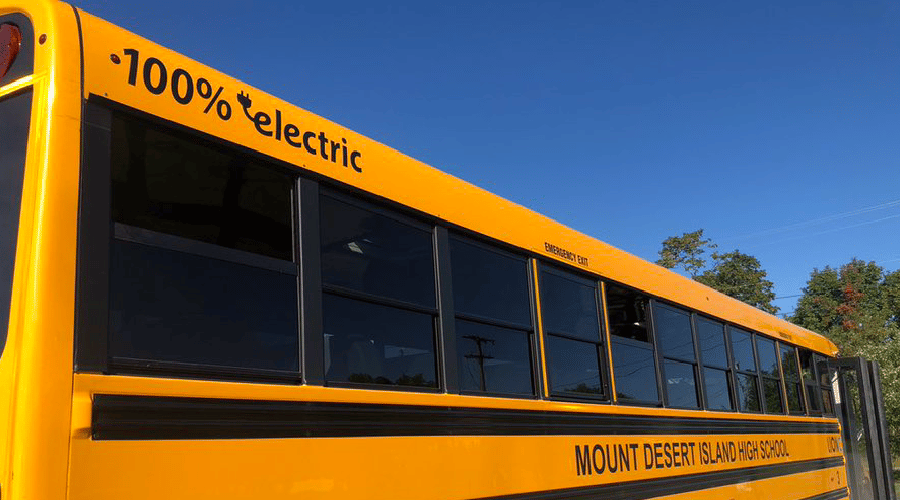Across the country, the humble yellow school bus is going green. According to data from the World Resources Institute’s Electric School Bus Initiative, 8,675 electric school buses (ESBs) have been ordered, delivered, put in operation, or funded through government awards to date.
The growing trend in adopting electric, zero-emission school buses means fewer children will face asthma risks and other health problems tied to diesel pollution, while enjoying reduced carbon emissions, savings on bus maintenance for strapped school budgets, and new green jobs.
The 2021 Bipartisan Infrastructure Law (BIL) served as the key driver for this growth so far, enabling the Environmental Protection Agency to award $5 billion through 2026 for school districts to purchase zero- or low-emission school buses. To date, the EPA’s Clean School Bus Program has awarded $1.84 billion in rebates and grants to replace over 5,100 diesel buses. Since electric school buses can cost up to three times more than diesel buses, most participating school districts have relied on available funding programs from the federal government, state government, and utilities to overcome the upfront cost barrier.
In addition to this critical source of federal funding, states are also stepping up with funding and policies that will continue to drive school bus electrification forward. The keys to success in these states can be found in the newly released guide from the Alliance for Electric School Buses, Driving Change: A State Playbook for Equitable Electric School Bus Policy.
We highlight below some successful strategies implemented by states that are in the ‘top of their class’ (using data provided by World Resources Institute’s Electric School Bus Data Dashboard, as of Feb 16, 2024).
California raises the bar with state funding
The state of California has long been the pioneer of electric school buses and it helped fund the first electric school bus in the country one decade ago. Now the Golden State accounts for approximately one-fourth of the electric school buses that are being deployed across the U.S. California cemented its leadership in clean transportation by passing a law in 2023 that calls for all of California’s new school bus purchases or leases to be zero-emission after 2035.

California school districts have been able to take advantage of over 40 different sources of funding for electric schools that were provided by the California Energy Commission (CEC), California Air Resources Board (CARB), local Air Districts, and utilities. The state’s Hybrid and Zero-Emission Truck and Bus Voucher Incentive Project (HVIP) has already funded over 1,000 electric school buses (which is double the number of electric school buses committed in New York). In our recent interview with Daniel Kang, Director of Transportation at Los Angeles Unified School District, he describes how state funding was critical to get the first 23 electric school buses on the road. Now he is working on meeting the district’s goal to electrify all 1,300 school buses and 2,300 other vehicles by 2040.
New York leads through electric bus mandates and support
With commitments for nearly 500 electric school buses, New York ranks second in the country for ESB adoption. In 2022, New York enacted the first statewide school bus electrification mandate in the country, which will require all new school bus purchases to be zero-emissions by 2027 and all of the roughly 47,000 school buses in the state to be electric by 2035. Subsequently, the New York Environmental Bond Act was passed and included $500 million for school bus electrification.
Transitioning New York’s entire school bus fleet will have its challenges, and the state has developed resources to help. The New York State Energy Research and Development Authority (NYSERDA) and the utility providers who cover the majority of the State’s school districts provide technical assistance to support school districts and fleet operators’ plan for the transition. In addition, the Electric School Bus Roadmap and Electric School Bus Guidebook were developed to provide school districts and bus operators with the technical and financial guidance necessary to remove fossil fuel vehicles from service and help reduce transportation emissions.
Maryland models public-private partnerships
With close to 400 electric school buses (5% of its statewide school bus fleet) on the way, Maryland currently ranks 4th in the nation for electric school bus adoption. The Climate Solutions Now Act of 2022 requires all new school bus purchases and contracts to be electric beginning in 2025, and the state’s largest school district is innovating a path forward for school districts to pay for the switch. Montgomery County Public Schools (MCPS) has one of the largest electric school bus fleet commitments in the country and one of the most aggressive electrification timelines nationwide. MCPS will replace 326 diesel school buses with ESBs by 2025, and it aims to have an entirely electric school bus fleet in 10 years. Electric charging infrastructure will also be installed at three bus depots in the district.
To achieve this large-scale transition, MCPS partnered with Highland Electric Fleets, which uses an innovative public-private partnership model that removes the upfront cost, provides driver and mechanic training, assists with charger installation, and offers other support. Highland Fleet’s model mimics the power purchase agreements (PPAs) that have helped schools draw on solar energy without the burden of steep upfront costs of solar arrays. As the largest buyer of electric school buses nationwide, Highland can eliminate overhead costs for districts and recoup that investment over time via decreasing bus prices, cheaper fuel and maintenance savings.
Baltimore City Public Schools (BCPS) is also leveraging a public-private partnership with Highland Electric to build out the second-largest ESB fleet in Maryland, with 25 ESBs to transport about 350 students. The Environmental Protection Agency’s Clean School Bus Program provided more than $9.4 million for their buses.
One in six Baltimoreans suffers from asthma and air pollution is a major contributor. Just through this first fleet transition alone, BCPS will avoid exposing their community to more than 200 tons of carbon dioxide a year.
We need to electrify for our children
These three states are among the many paving the way toward electric-powered school transit. It’s clear from the national data that school districts are eager to electrify.
Our leaders have the option to provide reliable and safe transportation for our children, reduce school bus maintenance fees, cut fossil fuel consumption, and save taxpayer dollars — all thanks to electric school buses. We need our states to leverage all the strategies, policies, and tools available to them to electrify our bus fleets, so we can ensure that all children across the country have access to clean air to breathe.














